Presented by:

This article appears in the E&P newsletter. Subscribe to the E&P newsletter here.
Modern monobore wells are drilled deeper and longer, enhancing productivity and reducing the cost per meter. However, these designs increase cementing challenges.
Sanjel Energy Services has developed a formation filming agent (FFA) that has proven to be a key technology in simplifying these operations, reducing overall cementing costs, and ensuring well integrity before and after completion operations are carried out.
The Challenge
In certain basins, the upper sections of the monobore can contain both weak, easily fractured areas and gas-bearing zones. The cementing solution to this challenge can be complex and multifaceted. The lead cement system must be lightweight and thin enough to reduce equivalent circulating pressures (ECDs) on the weak formations and get cement returns to surface, while also resisting gas migration in the slurry form via high solids ratio, short transition time and low permeability. The cement must also withstand completion operations stresses to be considered a success in the wellbore.
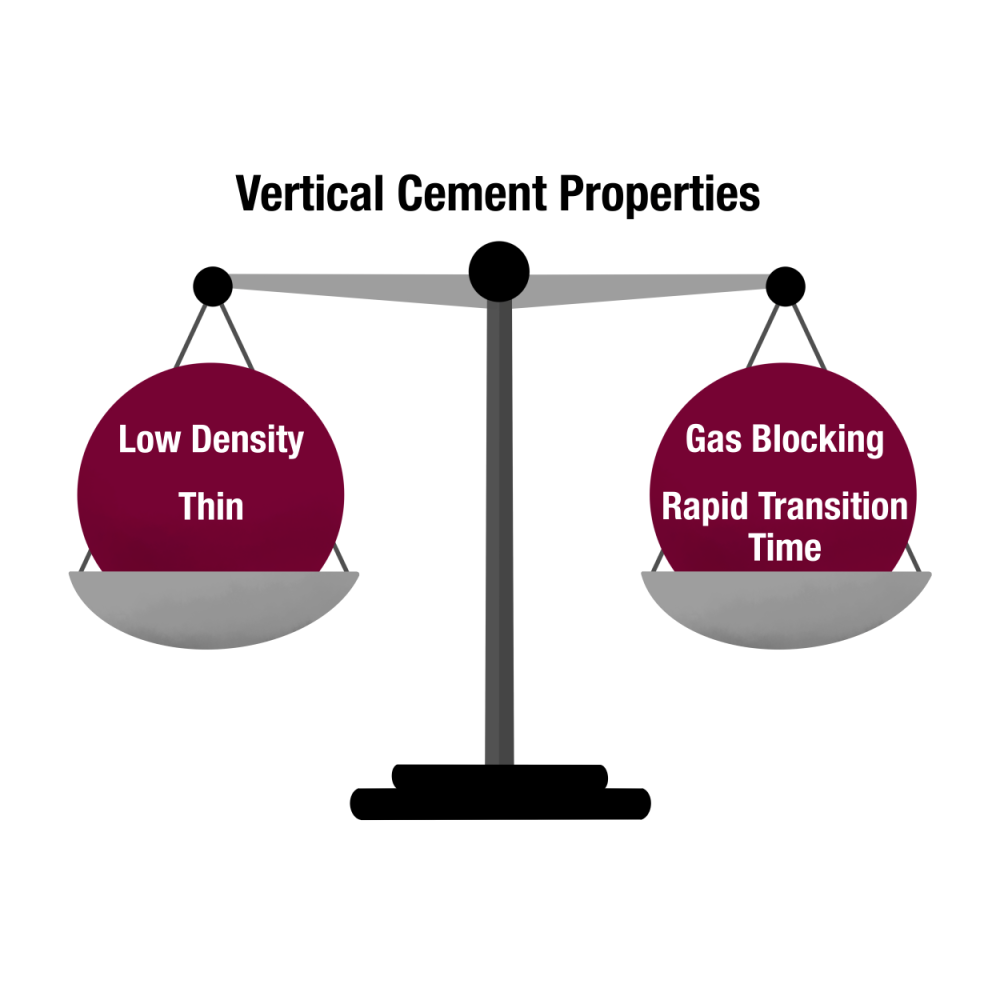
Some of the standard cementing options to address these challenges include running a stage tool and packer to isolate the weaker formations. This method is used less frequently due to risks of mechanical tool failure, tool costs, and the risk of losing casing integrity during fracturing.
Another common industry solution is to pump lighter weight blends, foam cements, or ultralightweight cements with glass beads to lower the density while maintaining good slurry properties for gas control. The last two technologies can be costly and operationally more complex to place successfully.
Although the lightweight blends may achieve the desired cement top, they are not always successful at mitigating surface casing vent flows (SCVF), they also make it difficult to achieve proper rheology and density hierarchy between the drilling fluid, spacer and lead cement that are acceptable in relation to industry standards. Utilizing a filming spacer is key to providing a solution.
About the Formation Filming Agent
To widen the rheology and density hierarchy, a slightly denser, thicker spacer and corresponding lead cement is required. These changes result in increased circulating pressures across the weaker zones. Sanjel Energy’s solution is to use an FFA in the spacer to strengthen and protect the weakest zones. The FFA lowers the risk of gas migration through the cement by restricting fluid or volume loss from the slurry, which is the void space needed to trigger migration through the slurry column.
The FFA is a powder that is easily added to Sanjel Energy’s patented Visweep DM IS spacer technology. Visweep DM IS (dry-mixed invert spacer) is bulk blended at a Sanjel Energy facility and transported to the drilling location. Visweep DM IS is mixed on-the-fly similar to a cement slurry, saving valuable rig time, eliminating the need to cut a significant number of bags of weighting material and adding the water wetting chemicals when batch-mixing a spacer. Eliminating these steps reduces chemical exposure and physical risk to the cementing crew.
The FFA was primarily developed to prevent lost circulation via sealing the formation face during the cement job. The chemical and mechanical mechanism increases the fracturing gradient, allowing for higher ECDs across weaker zones. During research, the additional benefits of reducing gas migration were discovered through lab testing, proving the FFA would help seal the formation wall, containing all the slurry to the annulus and reducing fluid loss to near zero.
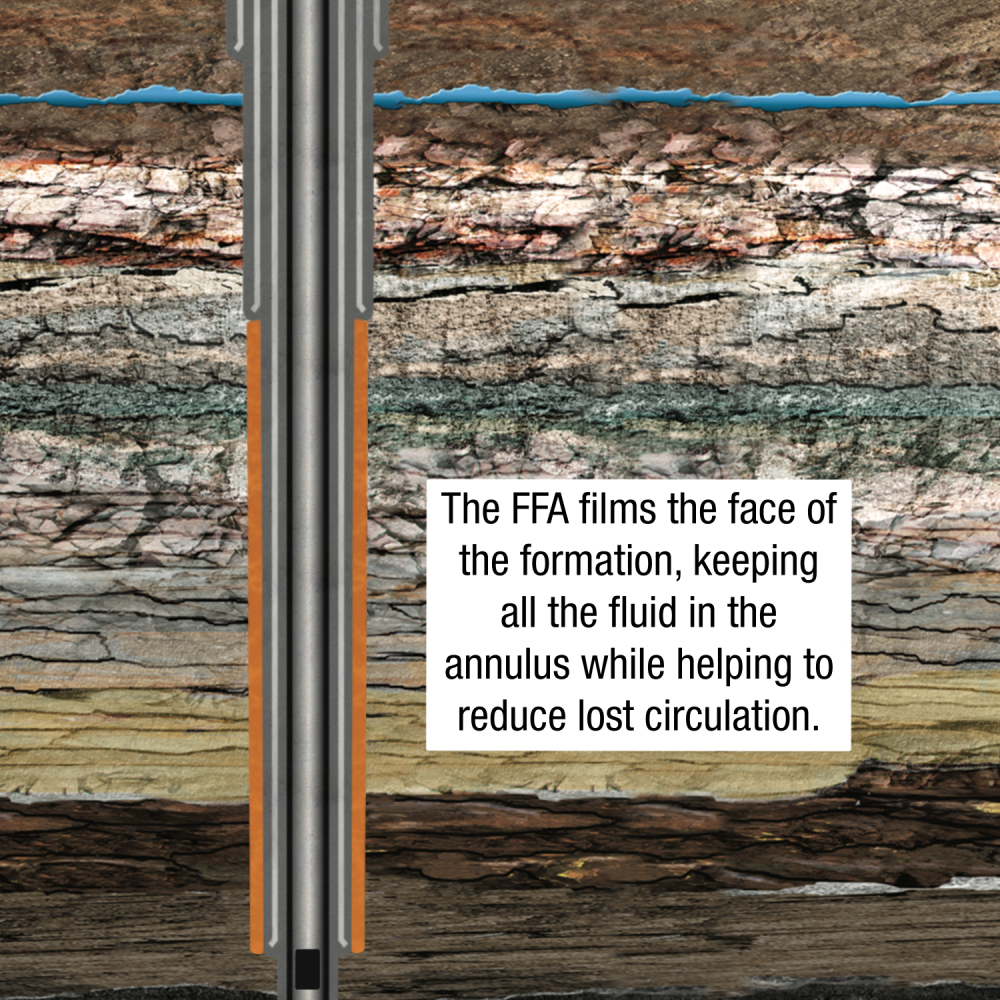
Field Trial Design
A field trial was designed to evaluate the potential of the FFA, including comprehensive lab testing of the rheologies and fluid compatibilities. A deeper understanding was needed to develop the optimum rheology and density hierarchy to maximize displacement efficiency and eliminate channeling. Fluid properties were inputted into the cementing software model where simulated pumping rates could be tested to understand maximum achievable annular velocity and how close to the fracturing gradient the downhole pressures would be. Other important variables which influence the pumping pressures were hole enlargement, centralization, fracturing sleeves in the lateral, and temperature effects as fluid travels from surface to the bottom of the well.
The final design for the field trial resulted in both the spacer and lead cement having a higher density and viscosity than the previous cementing program. The resulting ECDs uphole, below the surface casing shoe, increased by 36 kg/m3; although a small increase, these formations are very sensitive to any increases in downhole pressure. Table 1 shows the increase in density and viscosity of the fluids in the current system and the new FFA system.
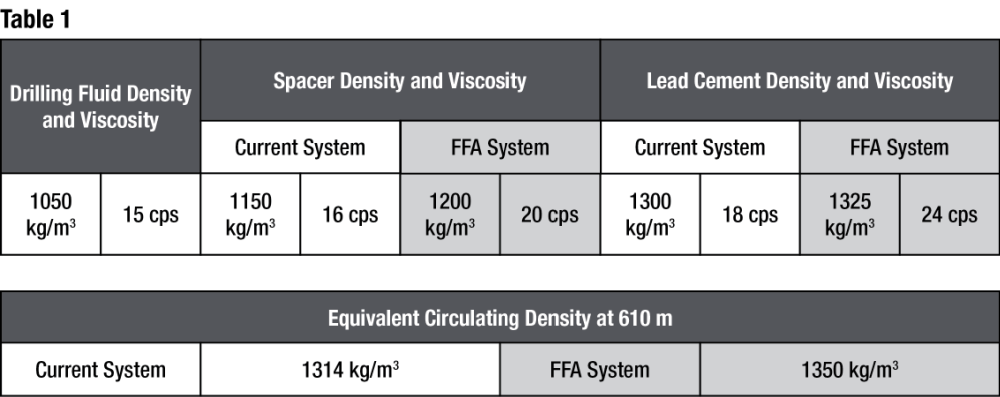
The combined increase in solids content, density and viscosity of the lead cement will reduce or eliminate gas penetration through the slurry during the hydration phase of cement setting.
The graphics below show the software simulation of low flow areas in the wellbore (in yellow) from ground level to approximately 750 m vertical depth for the Current System (Image 1) and the New FFA System (Image 2).
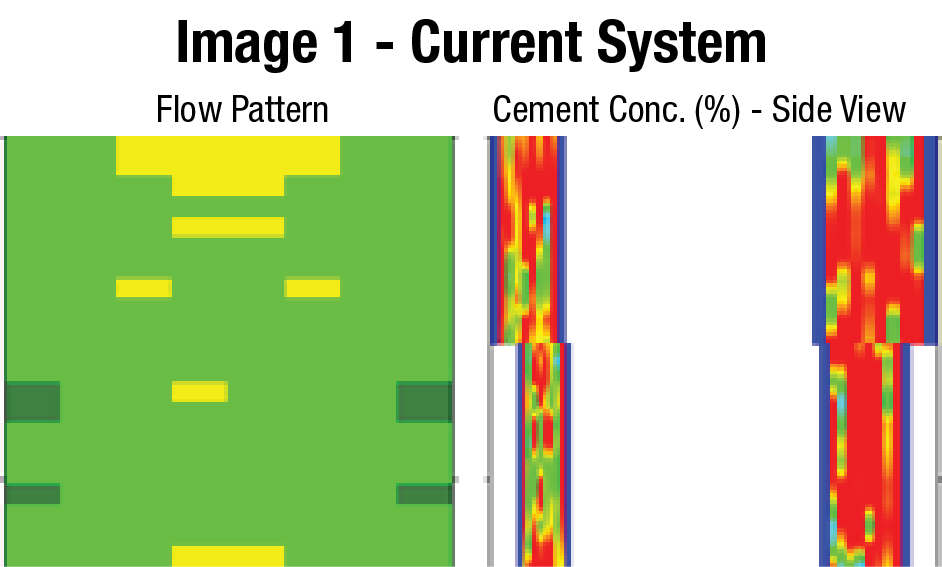
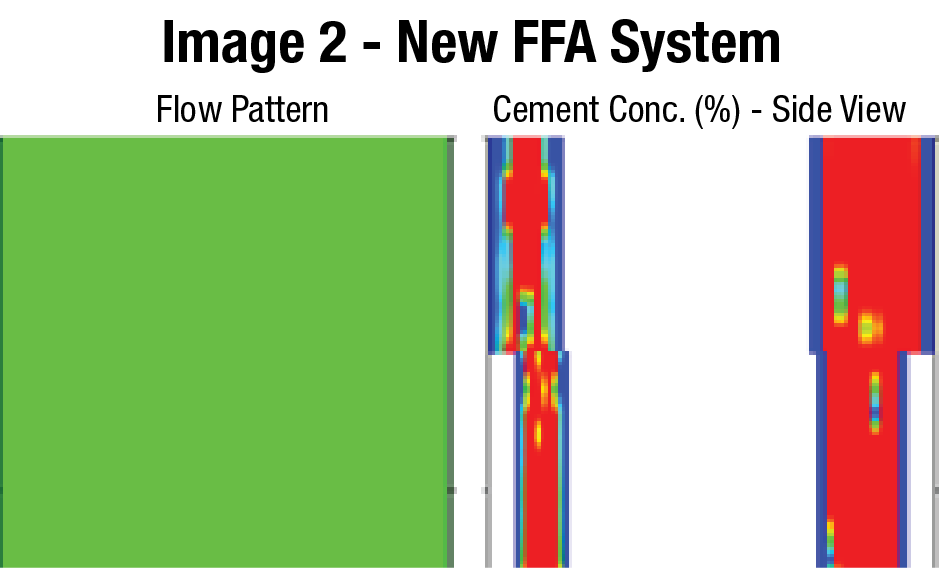
Field Trial Client Results
Sanjel Energy’s first field trial was a series of monobore oil wells targeting the Cardium Formation in Central Alberta. The wells were approximately 4,000 m in total length with 2,000 m vertical depth and 2,000 m lateral length and were an ideal case study due to the abundance of carbonate, sandstone, and siltstone formations to be covered. These types of formations are more likely to suffer lost circulation than harder, lower permeability shale producing formations. Gas bearing zones were present in the lower half of the vertical section and need to be covered by the tail cement.
Five wells pumped with the new design saw an average doubling in the amount of good cement returns and improved bond logs in the uphole sections. The rate of SCVF was found to be 0% before fracturing, and the post fracturing failure rate dropped from 50% to 20% during the five well trial.
The graphics below show the bond logs from ground level to approximately 750 m vertical depth for the Current System (Image 3) and the New FFA System (Image 4).
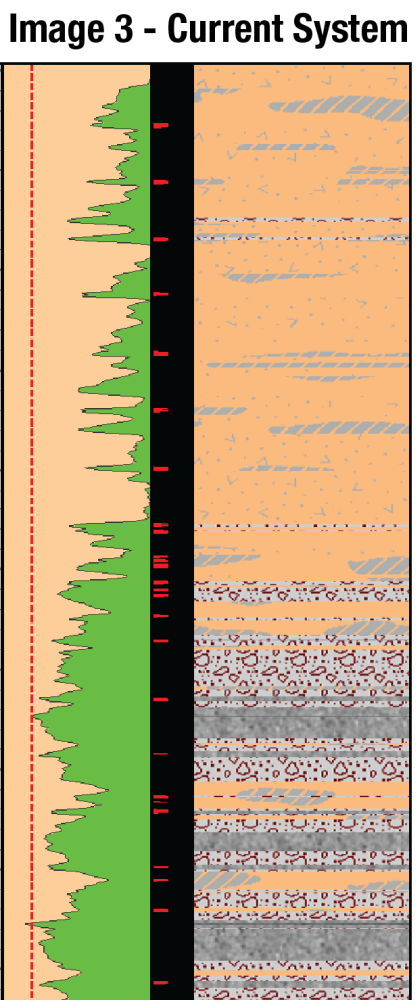
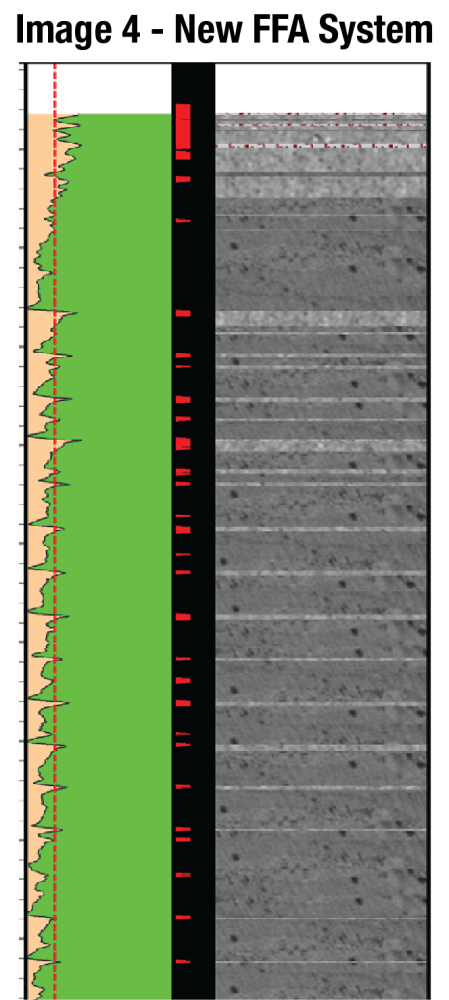
Sanjel Energy completed a second trial in the Gundy drilling area of Northern British Columbia. A client moved onto a new pad and experienced higher than expected gas pressures on the first well, leading to higher drilling fluid density, which carried through all nine wells on the pad. The cementing design was updated to utilize a heavyweight slurry (1901 kg/m3) on the intermediate casing string.
The first five wells developed a SCVF four to eight days after cementing. Sanjel Energy worked with the client to make changes to the cement job design to eliminate the SCVF’s. The cementing spacer was re-designed on the fly to include Visweep DM IS spacer employing the FFA. The FFA would provide a barrier to mitigate gas invasion into the column while reducing the cement fluid loss to near zero. Secondly, the FFA would help avoid lost circulation with a heavier cement slurry.
The four wells Sanjel Energy cemented using the re-designed spacer with the FFA were successful and did not show any vent flows.
Next Steps
The FFA has been proven to effectively reduce SCVFs when used with rigorous cement simulation and design. The technology is simple to employ in the field and costs less than more complex traditional solutions. Sanjel Energy Services will continue to use FFA as a strategy to improve well integrity.
Recommended Reading
CEO: Coterra ‘Deeply Curious’ on M&A Amid E&P Consolidation Wave
2024-02-26 - Coterra Energy has yet to get in on the large-scale M&A wave sweeping across the Lower 48—but CEO Tom Jorden said Coterra is keeping an eye on acquisition opportunities.
CEO: Magnolia Hunting Giddings Bolt-ons that ‘Pack a Punch’ in ‘24
2024-02-16 - Magnolia Oil & Gas plans to boost production volumes in the single digits this year, with the majority of the growth coming from the Giddings Field.
Chesapeake Slashing Drilling Activity, Output Amid Low NatGas Prices
2024-02-20 - With natural gas markets still oversupplied and commodity prices low, gas producer Chesapeake Energy plans to start cutting rigs and frac crews in March.
Will the Ends Justify the Means for W&T Offshore?
2024-03-11 - After several acquisitions toward the end of 2023, W&T Offshore executives say the offshore E&P is poised for a bounce-back year in 2024.
Exxon Mobil, Chevron See Profits Fall in 1Q Earnings
2024-04-26 - Chevron and Exxon Mobil are feeling the pinch of weak energy prices, particularly natural gas, and fuels margins that have cooled in the last year.




